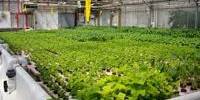According to a Rutgers study, symbiotic bacteria that infiltrate root cells can be controlled to produce hardier crops that require less fertilizer. The findings were published in the journal Microorganisms.
Bacteria that live in symbiosis with another organism or with each other are known as symbiotic bacteria. In ecosystems, symbiotic interactions are regarded to be important. However, due to experimental limitations, empirical data regarding the impact of symbiotic bacteria on plant communities is exceedingly limited.
Bacteria encourage the formation of root hairs in all plants that have them, thus the researchers looked at the chemical interactions between bacteria inside root cells and the root cell.
They discovered that bacteria are carried in seeds and absorbed from soils before being taken into root cells and producing ethylene, a plant growth hormone that causes root cells to generate root hairs.
When a root hair grows, it ejects some bacteria into the soil, but the bacteria that remain in the root hairs reproduce and cause a growth spurt every 15 minutes until the hairs are fully formed.
When root cells reach their maximum size, they begin to differentiate; this is an active process, not just the end of the cell cycle; differentiation in some root cells, such as root hair cells, necessitates extensive cellular re-modeling. There are three main types of symbiotic relationships: commensalism, mutualism, and parasitism.
- Commensalism is when one organism benefits and the other is neither harmed nor benefits.
- Mutualism is when both organisms benefit.
- Lastly, parasitism is when one organism benefits while the other organism is harmed.
Use of bacteria in plants may enable us to grow better developed and stress-resistant crops that require less fertilizers and thus will reduce environmental damage due to excess fertilizer applications with consequent runoff. Further, with the correct bacteria in crop plants, we may produce crops that are resistant to oxidative stresses stemming from climate perturbations, thus we may produce hardier and more resilient crops.
James White
In botany, the root is the underground portion of a vascular plant. Its key tasks include plant anchoring, water, and dissolved mineral absorption and transmission to the stem, and reserve food storage.
The root differs from the stem primarily in the absence of leaf scars and buds, the presence of a root cap, and the presence of internal tissue branching rather than buds. Plants and bacteria form a symbiotic relationship, allowing them to create nodules that aid in the conversion of atmospheric nitrogen to ammonia.
Cytokinins have been discovered to play a function in the establishment of root fixing nodules in this context. Not only does it appear that the plant requires nitrogen-fixing bacteria, but it also needs to be able to generate cytokinins that encourage the formation of root nodules, which are required for nitrogen fixation.
Ethylene is also a stress hormone that allows plants to adapt and grow more resistant to oxidative challenges such as heat, salt in the soil, heavy metals, and climate change-related pressures.
The researchers discovered that ethylene causes root cells to secrete superoxide, which causes bacteria to make nitric oxide, which helps to detoxify the superoxide. Nitric oxide reacts with superoxide to create nitrate, which root cells absorb.
Bacteria in root cells cause root hairs to develop and deliver nitrogen and other nutrients to root cells during this process. Bacteria that dwell in or on plant or animal tissue are known as symbiotic bacteria. Symbiotic bacteria in the digestive system aid in the breakdown of fiber-rich meals.
They also aid in the production of vitamins. Near hydrothermal vents, symbiotic microorganisms can live. Other bacteria usually have a mutual connection with them.
“This matters because it shows that the microbiome of plants is important for plant cell development, particularly root cell development, and nutrient supply,” said study co-author James White, a professor in the Department of Plant Biology in the School of Environmental and Biological Sciences at Rutgers University-New Brunswick.
“Use of bacteria in plants may enable us to grow better developed and stress-resistant crops that require less fertilizers and thus will reduce environmental damage due to excess fertilizer applications with consequent runoff. Further, with the correct bacteria in crop plants, we may produce crops that are resistant to oxidative stresses stemming from climate perturbations, thus we may produce hardier and more resilient crops.”
















